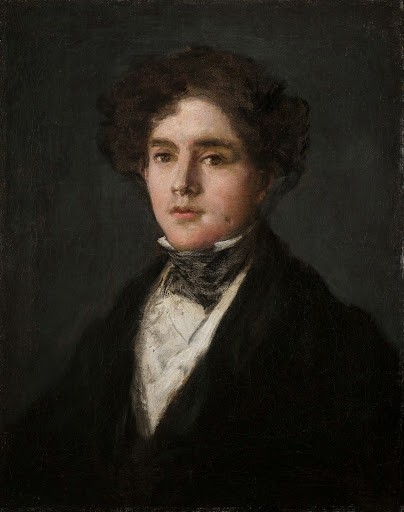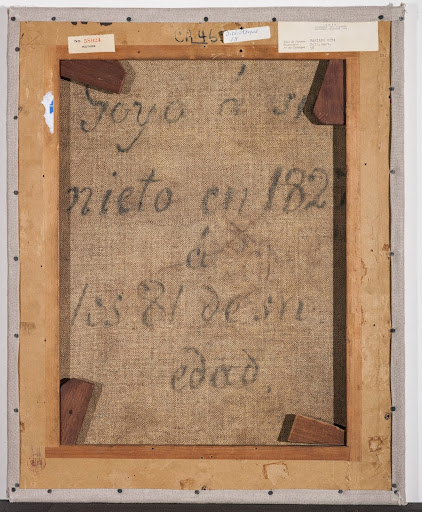Meadows Museum Unveils New Goya
Francisco Jose de Goya y Lucientes painted fewer than a dozen portraits between 1820 and 1828, the year he died at 81. But the one that made headlines is Portrait of Mariano Goya, which was recently unveiled at the Meadows Museum in Dallas.

Francisco José de Goya y Lucientes (1746-1828), Portrait of Mariano Goya, the Artist’s Grandson, 1827, oil on canvas. Meadows Museum, SMU, Dallas. Museum. Purchased with funds Donated by The Meadows Foundation and a Gift from Mrs. Eugene McDermott, in honor of the Meadows Museum’s 50th Anniversary, MM.2013.08. Photo by Dimitris Skliris
The portrait was acquired at a Sotheby auction in New York back in January. According to the Dallas Morning News, the auction price paid for the exquisite portrait was between $6 and $9 million dollars. Funding was provided by a gift from Mrs. Eugene McDermott and the Meadows Foundation.
The Meadows Museum is situated on the SMU campus. It houses the most comprehensive collection of Spanish art outside of Spain’s Prado museum. Artworks by Velasquez, Picasso, Murillo Sorolla, Goya, and others are among the museum collection, spanning the 10th to the 21st century.
The Portrait of Mariano Goya has not been on public display for more than 40 years, since it has been in the hands of a private collector. The shipping tycoon bought the oil-on-canvas painting in 1954. The painting was put on the auction block and sold in 2013.
“It’s a painting that’s been in private hands for 200 years,” Dr. Mark Roglan told a gathering of Dallas journalists at the unveiling. “In this painting, Goya shows us his grandson, who he loved and adored. You can see the love.”
Roglan, a native of Madrid, Spain, is director of the Linda P. and William A. Custard Meadows Museum and Southern Methodist University School of the Arts Centennial Chairman.
“Goya thought his grandson was a young man who was going to go to Paris and study art. Unfortunately, we know that he didn’t. But he was the last to carry his name,” Roglan said, pointing to a facial scar Mariano Goya may have suffered in a gambling related altercation.
Moreover, Goya’s grandson inherited the artworks from his famous grandfather, foremost Spanish artist of the early 18th and late 19th century. Mariano was not an artist nor art aficionado, so he lost the valuable inheritance through poor investments, said Roglan.

Reverse of Portrait of Mariano Goya, the Artist’s Grandson, Francisco José de Goya y Lucientes (1746-1828), 1827, oil on canvas. Meadows Museum, SMU, Dallas.
Mariano Goya, who was 21 years old when he sat for the painting, was the only grandson of the famous Francisco Jose de Goya y Lucientes. Regarded as the “first of the modernist” artists, Goya had one child who produced a grandchild. Stylistically, the portrait bridges tradition with modernity.
This blockbuster acquisition makes a total of six Goya artworks purchased by the museum. The Meadows was founded in 1965 by Texas oilman Algur H. Meadows and his wife, Virginia, after a visit to the Prado in Madrid.
“To be able to acquire six Goyas, including this last one of his grandson is extraordinary. This is also a great way to launch a celebration of the 50th anniversary of the Meadows Museum in 2015," Roglan said.
Visitors to the Meadows will find these five Goya paintings: Portrait of Francisco Sabatini; Yard with Madmen; Unfinished Portrait of a Lady; Students from the Pestalozzian Academy; and Still Life with Woodcocks.
The newly installed painting now hangs among a host of other great artworks from Spain as well, allowing the continued study of Goya and the full range of Spanish artists who are recognized around the world.
The Portrait of Mariano Goya also bolsters the museum’s position as a leader in acquisitions, exhibitions and scholarship in Spanish art. In fact, the current acquisition is surrounded by a famous Goya print series, the Desastres de la Guerra (Disasters of War) and Los Caprichos, a satire on human weakness and frivolity.
The Disasters of War chronicles the atrocities committed in Madrid when France invaded Spain under Napoleon in 1808. Goya’s other famous works include The Second of May, capturing the Spanish uprising, and The Third of May, illustrating the mass execution of Spanish resisters.
Goya was born March 30, 1746 in the village of Fuendetodos in northern Spain. At age 14, he moved with his family to Zaragoza and became an apprentice to Jose Luzan Martinez. Later, he traveled to Italy to study art. He served as royal court painter for four monarchs.

Portrait of Francisco de Goya, 1826, Vicente López y Portaña
From 1775 to 1792, Goya painted cartoons or designs of daily life for the Royal Tapestry factory in Madrid. His lengthy career as painter of Spanish aristocracy included being named painter to King Charles III of Spain in 1786.
Although Goya continued to paint under French rule, he used his talent as a painter-in spite of his blindness-to protest the injustices he saw before the French invasion and after Napoleon was toppled in 1814.

Portrait of the Count of Floridablanca (1728-1808), Goya
Goya retired to Bordeaux, France in 1824, a decade after Spain’s independence from France resulted in the reestablishment of the Bourbon King Charles IV. One of his most famous works is the painting of The Family of King Charles IV.
Goya left his home in France for the express purpose of visiting and painting his grandson in Madrid in 1827. Goya returned to France and died a short time after in 1828.
“We’re the third largest depository of Goya paintings in the United States. We have acquired paintings and sculptures. So it’s been an incredible year for acquisitions,” said Roglan.
The Meadows Museum is easily accessible from downtown Dallas. Museum hours: Tuesday-Saturday 10 a.m. to 5 p.m. Thursdays open until 9 p.m. Free admission Thursdays after 5 p.m. Sunday open 1 to 5 p.m. Closed Mondays. Admission is $10 for adults, $8 for seniors over 65, and $4 for non-SMU students. Children under 12 are admitted free.





















